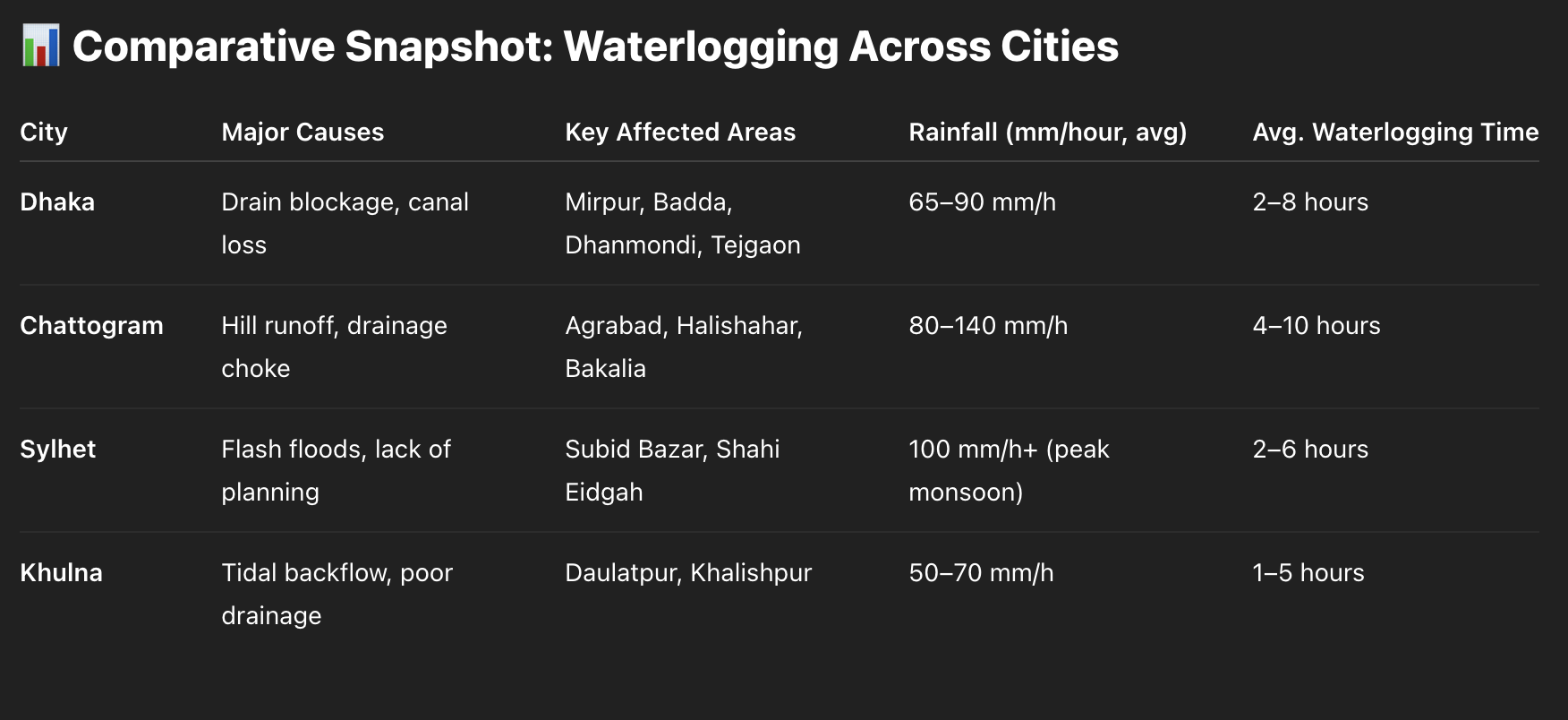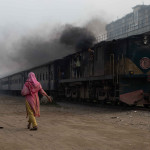Urban Waterlogging in Dhaka and Other Cities: Features, Analysis, and Strategic Solutions
Urban Waterlogging in Dhaka and Other Cities: Features, Analysis, and Strategic Solutions
Urban waterlogging has become one of the most critical climate and infrastructure-related crises in Bangladesh’s major cities—particularly Dhaka, Chattogram, Sylhet, and Khulna. Caused by a combination of unplanned urbanization, encroachment of water bodies, drainage failure, and extreme rainfall, waterlogging severely disrupts daily life, damages infrastructure, and impacts public health and economic productivity.
This report presents key features, root causes, data-driven insights, and a framework of actionable solutions to address urban waterlogging in Bangladesh.
Key Features of Urban Waterlogging
1. Drainage System Failure
- Cause: Outdated or clogged stormwater drainage systems cannot cope with rapid rainfall.
- Data Insight:
- Dhaka has 385 km of surface drains, but 70% are silted, according to DWASA.
- Impact: Major roads remain waterlogged for 2–10 hours after rain.
Case: In July 2023, an hour of 78mm rainfall caused knee-deep flooding in Dhanmondi, Mirpur, and Moghbazar.
2. Encroachment and Loss of Canals
- Fact: Dhaka once had 65 natural canals; over 30 have been encroached, filled, or vanished (RAJUK & BIWTA).
- Impact:
- No natural outlets for rainwater drainage.
- Disruption of hydrological connectivity with rivers like Buriganga and Turag.
Example: Kalyanpur canal is nearly blocked due to illegal structures and solid waste buildup.
3. Solid Waste Mismanagement
- Feature: Drainage lines are clogged with polythene, plastic, food waste, and construction debris.
- Data: DNCC and DSCC collect only 60–65% of daily waste; the rest ends up in open drains or canals.
Critical Point: Non-biodegradable plastic waste is the single largest contributor to urban drain blockage.
4. Low-lying Urban Topography
- Feature: Major areas in Dhaka (e.g., Badda, Rayerbazar, Mohammadpur, Jatrabari) are at lower elevation.
- Effect: These become water catchment zones during rainfall.
- Concern: These areas also have high population densities—making flood impact more severe.
5. Unregulated Urban Expansion
- Observation: Landfilling of wetlands and floodplains for housing and real estate projects reduces natural absorption.
- RAJUK Data:
- Over 2,500 acres of wetland have been lost in Dhaka’s periphery (2000–2020).
Example: Hatirjheel was once part of a massive wetland basin for natural water retention, now mostly concretized.
6. Climate Change and Extreme Rainfall Events
- Data Insight: Dhaka now experiences shorter but more intense rainfall events.
- Example: On July 5, 2023, Chattogram received 145mm rainfall in 2 hours, flooding over 40% of the city.
- Analysis: Climate-induced cloudbursts are overwhelming infrastructure designed for lower-intensity rain.

Critical Analysis
Infrastructure-Environment Disconnect
Urban development continues without alignment to hydrological maps or climate resilience assessments. This disconnect is a core reason water cannot drain effectively.
Governance Fragmentation
- Multiple authorities—RAJUK, WASA, city corporations, LGED—share drainage responsibilities with no unified command.
- Result: Projects often overlap or leave drainage gaps.
Socioeconomic Impact
- Loss of productivity due to delayed commutes.
- Rise in waterborne diseases like dengue and diarrhea post-waterlogging.
- Slum residents are the most vulnerable due to poor elevation and housing.
Study: BRAC Urban Development report (2022) found 28% of low-income families in Mirpur lost at least one workday per heavy rainfall due to waterlogging.
Strategic Framework for Mitigation
Short-Term Solutions:
- Emergency Pumping Stations in critical waterlogging hotspots.
- Drain Cleaning Blitz before monsoon—community participation campaigns.
- Temporary Sandbag Barriers for water redirection in key intersections.
Medium-Term:
- GIS-Based Drain Mapping for Dhaka, Chattogram, and Sylhet.
- Enforce Wetland Protection Act 2000—cancel illegal landfills.
- Establish Rapid Response Drainage Units in each city zone.
Long-Term Resilience:
- Nature-Based Drainage Systems: Rehabilitate canals, green swales, rain gardens.
- Rainwater Harvesting Policy for large buildings to reduce runoff.
- Unified Urban Drainage Authority to streamline governance and planning.
Conclusion
Waterlogging in Dhaka and other cities is not just a drainage issue—it is a crisis of urban planning, governance, and environmental justice. Restoring natural drainage, integrating green infrastructure, and building institutional coordination are essential for building resilient, flood-proof cities.


